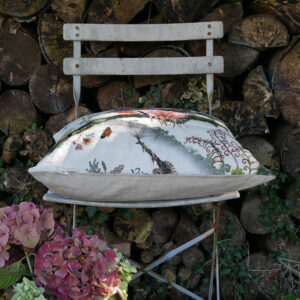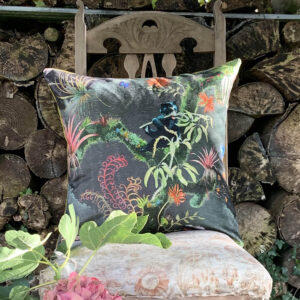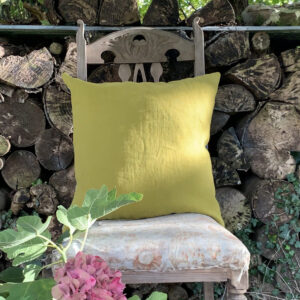Description
Wallpaper remnants are available for the cost of £0.1/cm.
£240 Original price was: £240.£74Current price is: £74.
Remnants of wallpaper that can be purchased for small projects. Sold for £1 per linear 10cm with the standard width of 70cm. This rolls is 735cm long (the full roll is 10m).
Out of stock
Wallpaper remnants are available for the cost of £0.1/cm.


This colourful linen velvet is an ususual and lustrous fabric, woven in the Netherlands and printed in Glasgow using reactive dyes, and sewn in Whitstable. The cushion pad is made in the UK.


This colourful linen velvet is an ususual and lustrous fabric, woven in the Netherlands and printed in Glasgow using reactive dyes, and sewn in Whitstable. The cushion pad is made in the UK.


Stock Sale
The Madidi Hummingbirds design is a tribute to the incredible diversity of Andean hummingbirds, of which there are 140 different species. This design features Andean Hillstars, Great Sapphirewings, and Giant Hummingbirds. These super-heroic little birds can fly at speeds which, relative to body length, are greater than any other vertebrate, with wing-speeds of over 80 beats per second. They also serve as specific pollinators for many flowers such as those in the Puya genus. The bases of these bromeliads are important bear foods and many have beautiful turquoise flowers. They also have natural antifreeze and some of the longest flower spikes in the world such as Puya raymondi, known as Queen of the Andes, the spherical plant bases and spikes depicted in this design. This plant grows to 15m (50ft) tall with 30,000 individual flowers when it blooms, which is once every one hundred years!
The contemporary design has quite an elegant structured style and a limited palate based around the blues and greens of the Puya flowers. With exquisite botanical detail, it builds upon the current passion in interiors for honouring the natural world. Furthermore, for every roll of wallpaper sold, 100m2 of critical wild habitat is preserved through World Land Trust.
This is an eco-friendly fine gicleé digitally-printed “real” wallpaper. It is printed in the UK on a natural non-woven cellulose-based substrate made from recycled materials, recycled polyester (PET) fibre and recycled wood pulp. The production process is solvent free with minimal waste and energy inputs.


Stock sale
The Andean spectacled bear, a mysterious and endangered species and inspiration for Paddington Bear, was the focus of my years of study in the Andean cloud forest of Bolivia’s Madidi National Park. During long periods spent alone for my research, I became obsessed with the intricate patterns and colour around me. Lichens, thin-lipped frogs, hummingbirds and toucans, along with my bears, were the subjects of my detailed drawings, and have formed the basis of this design. The composition of the design itself was inspired by a Josef Frank design from 1938 called Anakreon. His design was based on a 3,500-year-old fresco, discovered by a friend of Frank’s, from the palace in Knossos on Crete.
The design repeats once across the 70cm width of the wallpaper on the medium scale design. This design is also available in a large scale on a wide width wallpaper, at 137cm.
With exquisite botanical detail, this design builds on biophilic passion in interiors for honouring the natural world. Furthermore, for every roll of wallpaper sold, 100m2 of critical wild Habitat is preserved through World Land Trust.
This is an eco-friendly Fine gicleé digitally-printed “real” wallpaper. It is printed in the UK on a natural non-woven cellulose-based substrate made from recycled materials – recycled polyester (PET) fibre and recycled wood pulp. The production process is solvent free with minimal waste and energy inputs.


(This offer refers only to the wallpaper we have in stock.)
The Carolina Tree of Life collection celebrates the natural history of the Carolinas in the American South, where biologist and designer Susy Paisley spent much of her childhood. Carolina Posies is a lush, hand-drawn design which celebrates wild species of the Southern States of the Carolinas. The designer is a conservation biologist who grew up in this beautiful area. The rich colors and graphic details are matched by the interest of the many extraordinary species depicted, including monarch butterflies and their larval foodplants, milkweed, Carolina Reaper chilli peppers, devil’s paintbrush, pine barren gentian, grass of Parnassus and carnivorous plants. It is a detailed botanical with an enchanting meandering feel.
Companion prints include Carolina Tree fo Life and Carolina Monarchs,
featuring details from this larger scale design.


Stock sale
This pattern shows English species suggested to me by the imaginary species in Dr Suess’s The Lorax. It is organised in an ogee pattern, made of ribbons. They remind me of the double helix of the DNA that determines how we all turn out, every living thing, and of chain link fences, and breaking through them to get out into nature.
The humming fish are represented by great crested newts, the precious truffula trees are clover flowers whilst the playful barballoots are the red squirrels. The bees which also feature in a companion print are short-haired bumblebees – a wonderful conservation success story as they were extinct in the UK but acres of flower-rich meadows were planted in Kent, the bees were reintroduced and are now thriving. Other flowers include several species of clover, Pheasant’s eye, crested cowwheat, Stinking iris, whorled millifoil, Carthusian pinks, Herb Paris, wintergreen and blossoms of a rare old English breed a apple. Great great grandfather snail is the lagoon spire snail (thought extinct, but recently found in Chichester harbour)
Companion prints include Mercia Ribbons and Mercia bees, featuring details from this larger scale design.


This colourful linen velvet is an ususual and lustrous fabric, woven in the Netherlands and printed in Glasgow using reactive dyes, and sewn in Whitstable. The cushion pad is made in the UK.


This colourful linen velvet is an ususual and lustrous fabric, woven in the Netherlands and printed in Glasgow using reactive dyes, and sewn in Whitstable. The cushion pad is made in the UK.